
 By The PhantomBuster Team
By The PhantomBuster TeamWhether you’re prospecting for new leads or refining your close rate, having the right sales statistics at hand can make all the difference.
This blog pulls together key sales statistics to help your sales team sharpen their lead generation strategies.
Sales prospecting statistics
Prospecting is one of the toughest parts of the sales process. It involves finding the right sales leads and getting in front of them—whether through referrals, cold calls, or social media.
Here are some recent sales statistics you need to know:
96% of prospects do research before speaking to sales professionals (HubSpot)
22% of respondents use automated lead generation tools, with AI playing a big role in prospecting (Pipedrive).
180% increase in deals came from improving prospecting strategies (Hubspot).
74% of companies have at least 21 SDRs, showing their importance in pipeline generation (Outreach).
38% of companies in the $250M–$1B range rely on SDRs to generate nearly half of their sales pipeline (Outreach).
80% of B2B sales now happen virtually, creating both opportunities and challenges for prospecting (Salesroom).
54% of executives focus on improving sales productivity, including prospecting, through AI and tech consolidation (State of Sales Enablement report, Highspot).
82% of sales professionals had to adapt quickly due to global challenges like inflation (Salesforce).
40% of salespeople say prospecting is the toughest part of the sales process (HubSpot).
82% of buyers accept meetings with salespeople who reach out proactively (HubSpot).
71% of prospects prefer doing their own research over interacting with a sales representative (HubSpot).
 Consumer preferences of sales experiences | HubSpot
Consumer preferences of sales experiences | HubSpot63% of sales representatives still rely on cold outreach (HubSpot).
37% of sales reps generate the most leads from phone calls during cold outreach (HubSpot).
72% of sales reps use social media for prospecting, with Facebook, Instagram, and YouTube being the top platforms (HubSpot).
Social selling statistics
Social media has become an essential tool for sales.
Building connections, engaging prospects, and nurturing relationships on platforms like LinkedIn can open doors to new opportunities.
31% of sales reps using social selling closed deals worth over $500,000 without meeting buyers in person (LinkedIn)
Sales professionals with a strong LinkedIn social selling index have 45% more sales opportunities than those who don’t (LinkedIn).
64% of social sellers say community engagement is the most effective way to encourage user-generated content, followed by incentives like discounts and rewards (HubSpot).
45% of sellers say the ability to build and engage a community is the most important feature of a social media platform for social selling (HubSpot).
25% of sales pros win deals with help from social media content (Hubspot).
Over 50% of social sellers see audience targeting as a key benefit of social selling (HubSpot).
78% of businesses that use social selling outperform those that don’t (LinkedIn).
 Social selling leaders get better sales results | LinkedIn
Social selling leaders get better sales results | LinkedInBusinesses prioritizing social selling are 51% more likely to reach their sales quota (LinkedIn).
Audiences exposed to brand messages on the platform are 6x more likely to convert (LinkedIn).
87% of businesses say user-generated content (UGC) increases sales, while 92% say it boosts brand awareness (HubSpot).
25% of social media users have bought a product based on an influencer’s recommendation (HubSpot).
45% of sellers believe building a community and engaging actively is the most important feature for social selling on any platform (HubSpot).
Social media ranks as the fourth most effective sales channel (HubSpot).
Lead nurturing statistics
Not every lead converts right away.
Consistent communication and value-driven interactions help keep prospects engaged until they’re ready to buy.
Companies that excel at lead nurturing generate 50% more sales-ready leads at a 33% lower cost (Hubspot)
31% of companies report supporting post-sales enablement to enhance customer retention through nurturing relationships (Highspot).
65% of marketers aren’t using a lead nurturing program (Ascend2).
69% of marketers rely on email marketing as their main channel for lead nurturing (Ascend2).
46% of B2B marketers use social media to nurture leads (Demand Gen Report).
62% of B2B marketers use lead nurturing primarily to segment leads based on behavior or interest (Demand Gen Report).
49% of successful B2B marketers benchmark new strategies, compared to only 37% of those who aren’t successful, who test only failing strategies (Ironpaper).
Lead qualification statistics
Identifying the right leads is essential for sales success.
Spending time on qualified prospects—those who fit your ideal customer profile—yields better results. Here are some key sales statistics about lead qualification:
67% of lost sales happen due to poor lead qualification (Hubspot)
33% of respondents say opportunity management is their biggest struggle, impacting the sales pipeline (Outreach).
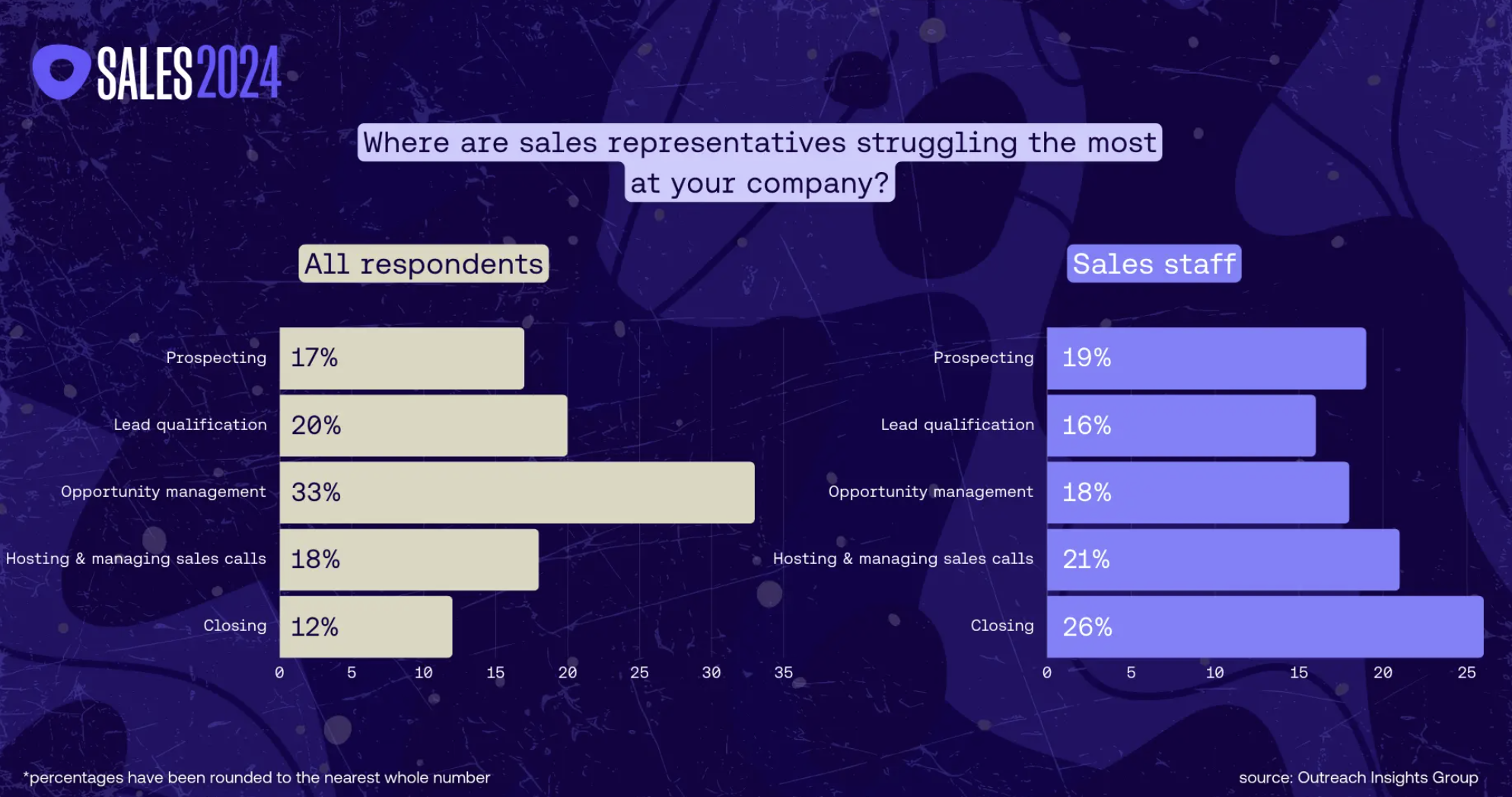 Sales reps struggle with opportunity management | Outreach
Sales reps struggle with opportunity management | Outreach75% of sales reps don’t consistently follow their methodologies, but 72% see AI as a solution to improve adherence (Salesroom).
30% of organizations are prioritizing pipeline generation and conversion for 2024 (Highspot).
70% of marketers rated their leads as "high quality" (HubSpot).
64% of respondents identified outdated data as their biggest challenge in maintaining database quality (DemandGen).
49% of lead practitioners now incorporate intent data into their lead qualification strategies (DemandGen).
60% of marketers listed generating warmer, sales-ready leads as their top priority (DemandGen).
45% of content marketers cite attracting valuable leads as their top challenge this year (Semrush).
66% of respondents currently work for data-driven sales teams, while 22% aim to shift towards a metrics-based approach for lead generation (Digital Marketing Depot).
75% of marketers still rely on third-party identifiers to enhance leads, but upcoming regulations may limit this access (Salesforce).
58% of respondents find generating high-quality leads more difficult now than two years ago (DemandScience).
Sales follow-up statistics
Following up is where deals are often won. The right timing and persistence ensure that good opportunities don’t slip through the cracks.
60% of customers reject offers up to four times before buying (Invesp)
82% of sales professionals see building relationships as the most rewarding part of the sales process (HubSpot).
36% of sales managers prioritize follow-ups to high-quality leads as their most important tracking metric (HubSpot).
30% of sales managers focus on the number of proposals sent as their key productivity measure (HubSpot).
32% of managers track emails sent as their top productivity metric (HubSpot).
80% of successful sales require at least five follow-up calls (Invesp).
Nearly 48% of salespeople never follow up after the first attempt (Invesp).
44% of salespeople give up after a single follow-up (Invesp).
The first follow-up email can increase reply rates by 49% (Belkins).
B2B outreach campaigns with two follow-up emails yield the best results (Belkins).
Pausing for 2 to 5 days before a follow-up leads to higher response rates (Belkins).
Cold outreach campaigns with three email rounds (initial + 2 follow-ups) achieve the highest reply rates, averaging 9.2% (Belkins).
 Optimal number of follow-ups to achieve the highest reply rates | Belkins
Optimal number of follow-ups to achieve the highest reply rates | BelkinsSales reps spend just 28% of their time selling, with the rest dedicated to admin tasks like data entry (Salesforce).
Teams using post-sales analytics are 2x more likely to boost customer retention (Highspot).
43% of sales professionals spend between 10 and 20 hours each week on note-taking and CRM data entry (Salesroom).
Sales closing statistics
The right closing approach, such as personalizing offers or highlighting key benefits, can make a big difference in sealing the deal.
29% was the average sales close rate in 2023 (HubSpot)
52% of executives are focused on cross-sell and upsell revenue as a major growth strategy (Hubspot).
The average win rate for sales teams in 2023 stood at 21% (HubSpot).
The median deal size for 2023 came in at $4,000 (HubSpot).
 Sales professional benchmarks | HubSpot
Sales professional benchmarks | HubSpot38% of reps say attentiveness is the best way to build rapport on a sales call, with finding common ground at 29% and pre-call research at 25% (Hubspot).
42% of B2B sales pros say researching a prospect’s challenges is the most effective way to make the sale (Hubspot).
45% of reps focus on upselling, while 31% say understanding a prospect’s needs is key to closing deals (Hubspot).
48% of salespeople use free options to convert, with 50% finding free trials most effective (Hubspot).
Only 52% of sales calls include a direct attempt to close (LinkedIn).
42% of companies saw their win rates decline last year (Lighthouse).
Sales performance statistics
Tracking key performance metrics helps sales teams spot areas for improvement and measure their success. It’s an essential part of growing revenue.
21% is the average sales win rate (HubSpot)
91% of salespeople engage in upselling, contributing an average of 21% to company revenue (HubSpot).
87% of sales pros cross-sell, adding another 21% to company revenue (HubSpot).
81.2% of respondents say a lack of flexible payment options held back deals (Capchase).
42% of companies saw a drop in win rates in 2023 (Lightspeed).
High performers are nearly 2x more likely to use AI than underperformers (Salesforce).
43% of sales managers prioritize CRM usage as a top productivity measure (HubSpot).
38% of managers believe sales technology deliver the most valuable metrics (HubSpot).
29% of sales managers say scheduled meetings are their key productivity metric (HubSpot).
72% of company revenue comes from existing customers, while 28% is generated from new customers (HubSpot).
In 2023, 61% of respondents met their personal sales goals, a steady percentage (Pipedrive).
 Percentage of sales representatives who met their personal goals | Pipedrive
Percentage of sales representatives who met their personal goals | Pipedrive75% of salespeople feel confident in their company’s ability to reskill reps, up from 63% in 2020 (Salesforce).
Teams using AI are 3x more effective at hitting their sales targets (Highspot).
AI adoption makes teams 4x more likely to improve satisfaction and 3x more likely to boost productivity (Highspot).
76% of executives believe sales enablement tools have improved their sales process and performance (Highspot).
Only 11% of sales professionals feel confident making sales calls, with 70% struggling most with objection handling (Salesroom).
76%-90% of Account Executives in companies with revenue between $250M and $1B hit their targets in 2023 (Outreach).
61% of sales leaders cite budget uncertainty as the main factor affecting 2024 growth (Outreach).
54% of salespeople found 2023 harder due to inflation and competition (Hubspot).
Hybrid sales teams outperform others by 28% (Hubspot).
71% of salespeople hit their quotas regularly in 2023, up 19 points from 2022 (Pipedrive).
61% of respondents reached personal sales targets, consistent with recent years (Pipedrive).
67% of people at companies with over 100 employees hit their goals, while smaller firms saw 11% fewer employees meet targets (Pipedrive).
Cold calling statistics
Cold calling, while considered traditional, still works. It’s all about persistence and targeting the right prospects at the right times.
37% of salespeople find cold calls the most effective cold outreach method (HubSpot)
31% of sales managers consider the total number of sales calls a key productivity metric (HubSpot).
The best time to make sales calls is between 4:00 and 5:00 pm (Callhippo).
Wednesday stands out as the most effective day to call leads (Callhippo).
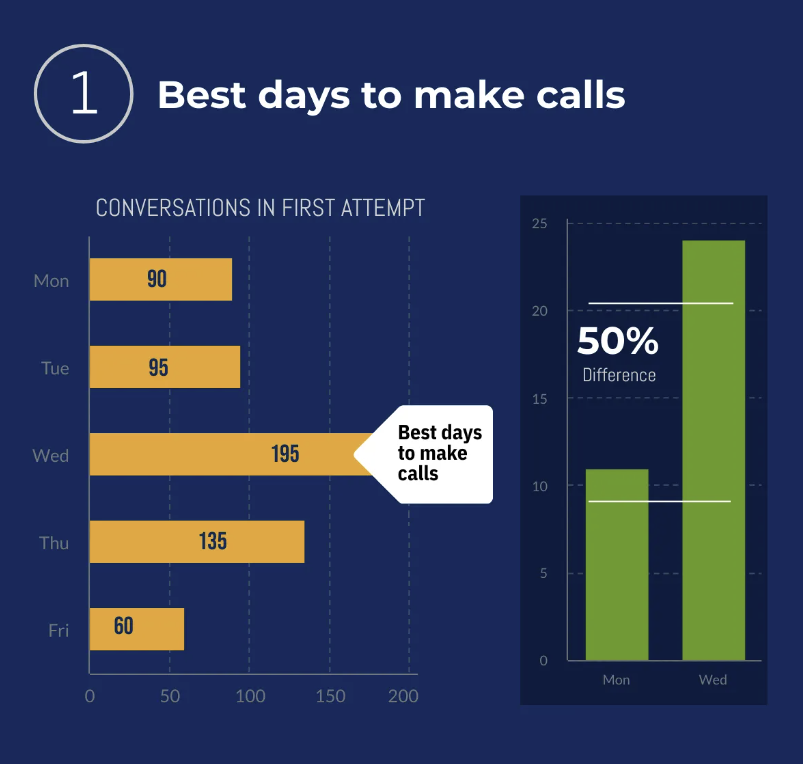 The most effective day to call leads | Callhippo
The most effective day to call leads | CallhippoThe average sales rep makes 33 calls/day (Zippia).
Inside sales reps achieve an average of 6.6 conversions per day (Zippia).
11:00 am to 12:00 pm is the second-best window to reach prospects (Callhippo).
Calling within an hour of receiving an inquiry delivers the highest success rate (Callhippo).
Mondays and Friday afternoons are the worst times for calling prospects(Callhippo).
Email outreach statistics
Email remains one of the most effective ways to reach out to leads. Personalizing content and sending at optimal times increases response rates.
35% of respondents use email marketing automation tools, similar to AI tools (Pipedrive)
33% of people decide to open or discard emails based purely on the subject line (SuperOffice).
70% of salespeople send just one email to a prospect (Invesp).
Subject lines with seven words achieve the highest open rate at 46.2% (Regie.ai).
Email copy with 144 words generates the highest reply rate at 2.7% (Regie.ai).
81% of companies use email as part of their marketing strategy (Forbes).
64% of small businesses use email marketing (Forbes).
Personalized emails increase open rates by 26% (Forbes).
Over 50% of companies send emails two to four times per month (Forbes).
The average open rate for an email campaign is 36.5% (Forbes).
Tuesday at 12 PM is the most popular time to send an email campaign (Forbes).
Sales CRM statistics
A good CRM system is essential for keeping sales teams organized and on top of their tasks. It helps manage customer relationships and track interactions efficiently.
97% of salespeople say CRM is crucial to their success (LinkedIn)
87% of respondents track sales using CRM software, with the highest adoption among smaller businesses (Pipedrive).
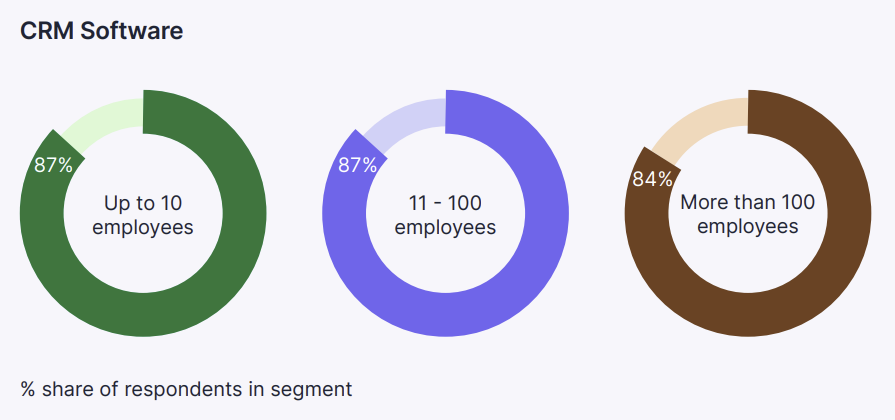 CRM software adoption | Pipedrive
CRM software adoption | Pipedrive
82% of respondents satisfied with their tools consistently hit sales quotas, highlighting the role of CRM in success (Pipedrive).
33% of respondents struggle with opportunity management, often tied to inefficient CRM use (Outreach).
68% of sales professionals cite note-taking and CRM data input as their most time-consuming tasks (Salesroom).
75% of sales teams have less than 80% confidence in their CRM data (Salesroom).
Only 2% of respondents feel over 90% confident in the accuracy of their CRM data (Salesroom).
75% of sales managers believe CRM improves their processes and customer insights (Hubspot).
Salespeople spend 19% of their time updating CRM tools (LinkedIn).
78% of sales professionals report CRM improves their sales (HubSpot).
41% of salespeople struggle with outdated CRM data, calling it a major challenge (LinkedIn).
Sales AI statistics
AI lead generation is reshaping the sales landscape by handling tasks like lead scoring and follow-ups, so reps can focus on closing deals.
30% of sales teams automate their sales processes with AI (HubSpot)
63% of sales leaders say AI helps them stay competitive in their industry (Salesroom).
47% of companies report improved lead generation using AI tools (Lighthouse).
33% of sales organizations currently use AI (Salesforce).
Teams using AI see a 41% improvement in forecasting accuracy and 43% better time management for sales reps (Salesforce).
AI improves lead scoring by 43% and customer personalization by 45% (Salesforce).
Organizations using AI for task automation and insights are 3x more likely to improve productivity (Highspot).
Sales teams using AI coaching tools are 50% more likely to improve quota attainment (Highspot).
Nearly 80% of sales professionals see AI’s value in automating repetitive tasks and providing real-time coaching (Salesroom).
74% of respondents find AI valuable in automating tasks, freeing up hours in their sales process (Salesroom).
66% of sales professionals appreciate real-time AI tools like battle cards and script reminders (Salesroom).
41% of AI-using teams report improved forecast accuracy, and 43% see moderate improvements Outreach).
67% of sales professionals believe AI will help buyers make informed decisions without interacting with sales reps by 2024 (Hubspot).
AI tools save sales professionals 2 hours a day, giving them more time to build relationships and close deals (Hubspot).
81% of sales pros say AI reduces manual tasks, while 82% believe it boosts efficiency (Hubspot).
35% of respondents already use AI tools, with smaller companies seeing a higher share at 42 (Pipedrive).
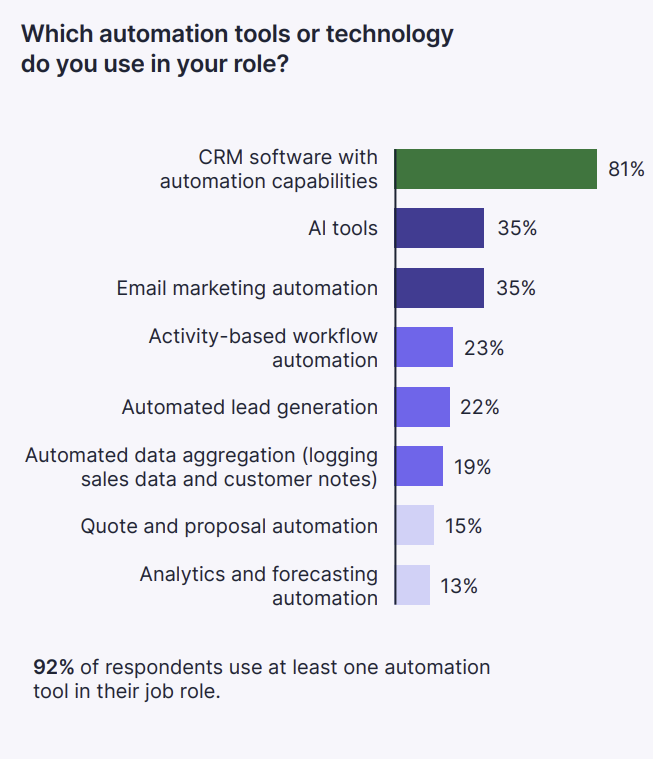 Automation tools | Pipedrive
Automation tools | Pipedrive38% of respondents think AI tools will positively impact their work when adopted (Pipedrive).
76% of respondents believe AI will support them at work, while only 8% fear team size reductions (Pipedrive).
78% see value in AI presenting real-time insights during sales calls (Salesroom).
74% think real-time coaching and conversational intelligence via AI would enhance their sales efforts (Salesroom).
81% of sales leaders believe AI can reduce time spent on manual tasks (Salesroom).
19% of sales pros see generative AI tools as a game-changer for product research (HubSpot).
41% of salespeople using AI focus on understanding and responding to emotional sentiment (HubSpot).
Only 38% of those using AI for sentiment analysis find it very effective (HubSpot).
Sales tools statistics
Sales tools make processes more efficient. Teams that adopt the right tools often see improved productivity and better results.
92% of sales teams use at least one automation tool, with CRM and email marketing being the most common (Pipedrive)
73% of respondents are satisfied or very satisfied with the tools and technology they use (Pipedrive).
45% of sales pros feel overwhelmed by the number of tools in their tech stack, prompting companies to consider tech stack audits (Hubspot).
Sales Hub tools led to a 180% increase in deal generation for Ceros (HubSpot).
80% of teams using a unified enablement platform report higher win rates (Highspot).
72% of executives say their sales enablement tech investments improved performance (Highspot).
94% of sales organizations plan to consolidate their tech stack in the next 12 months (Salesforce).
Sales teams use an average of 10 tools to close deals (Salesforce).
83% of sales professionals think their organization fully utilizes its CRM, but only 37% strongly agree (Salesforce).
47% of top-performing salespeople use automation tools to increase productivity (HubSpot).
81% of sales leaders believe AI reduces time spent on manual tasks (HubSpot).
52% of sales pros saw more B2B customers using self-serve tools compared to last year (HubSpot).
Sales professionals providing self-service tools are 47% more likely to exceed their targets (HubSpot).
Sales management tools, engagement platforms, and prospecting tools each deliver the highest ROI at 27%, 26%, and 25% respectively (HubSpot).
 The sales tools with the highest ROI | HubSpot
The sales tools with the highest ROI | HubSpot66% of sales pros think AI helps them better understand customers and provide personalized experiences (HubSpot).
Sales enablement tool adoption in the U.S. increased by 20% in 2023 (HubSpot).
1 in 4 sales leaders believe they have too many tools in their tech stack (HubSpot).
29% of sales professionals say streamlining their tech stack would improve efficiency (HubSpot).
78% of salespeople find their CRM effective in enhancing sales and marketing alignment (HubSpot).
69% of sales leaders plan to invest in prospecting technology (Prezentor).
Inbound sales statistics
Inbound sales focus on leads who already express interest. This approach can lead to quicker conversions when paired with timely and helpful content.
Inbound leads cost 61% less on average than outbound leads (HubSpot)
Companies connect with buyers through an average of 10 channels, including email, social media, and online portals (Salesforce).
35% of organizations expect their budget for sales enablement to increase, partly driven by expanding inbound sales efforts (Highspot).
73% of sales teams report recording their sales meetings, but only 44% review those recordings with managers for feedback (Salesroom).
73% of respondents say at least 21% of their sales pipeline is generated from inbound marketing leads (Outreach).
 Percentage of the company's pipeline coming from inbound marketing leads | Outreach
Percentage of the company's pipeline coming from inbound marketing leads | OutreachOutbound sales statistics
Outbound sales remain a key strategy for filling the pipeline.
Targeted warm outreach, whether through a sales call or an email, helps bring in new opportunities.
30% of organizations are focusing on pipeline generation for outbound sales in their 2024 strategy (Highspot)
31%–40% of pipeline generation comes from SDR outbound efforts, highlighting the importance of outbound sales activities (Outreach).
34% of deals are closed completely virtually, while another 34% follow a hybrid approach (Salesforce).
92% of B2B customer interactions happen over the phone (HubSpot).
Outbound performs best for companies with fewer than 500 employees (Ebsta).
Only 16% of marketers believe outbound generates high-quality sales qualified leads (Ironpaper).
52% of outbound marketers find their strategies ineffective (Ironpaper).
57% of C-level buyers prefer phone contact (Crunchbase).
43% of buyers using self-service digital commerce report higher regret post-purchase (Gartner).
50% of CSOs expect enablement to support marketing and customer success in three years (Gartner).
35% of B2B decision-makers are willing to spend over $500,000 via remote channels (McKinsey).
B2B sales statistics
B2B sales involve complex buying processes and longer cycles.
Building trust and offering tailored solutions are key to winning bigger contracts.
Here are some recent B2B sales statistics:
The B2B industry is projected to grow to $31 billion by 2031 (StraitsResearch)
64% of B2B sales pros now offer self-service tools like product demos and free trials, with 85% finding it effective (HubSpot).
77% of B2B buyers described their latest purchase as very complex or difficult (HubSpot).
81% of sales reps say buyers conduct more research before reaching out (Salesforce).
80% of sales reps believe maintaining customer relationships post-sale is more important than ever (Salesforce).
 Customer retention becomes a key performance indicator | Salesforce
Customer retention becomes a key performance indicator | Salesforce65% of sales teams report being only somewhat effective at achieving their goals, suggesting room for improvement (Highspot).
Sales teams forget 70% of the information learned within a week of training, and 87% forget it within a month (Salesroom).
61% of sales reps say selling has become harder than it was 10 years ago (Salesroom).
91% of sales professionals upsell, contributing an average of 21% to company revenue (HubSpot).
B2B sales pros rely on rapport-building and face-to-face meetings to establish trust during complex sales (HubSpot).
53% of companies experienced longer sales cycles in 2023 (Lightspeed).
Sales career statistics
Sales careers offer plenty of growth and earning potential. Continuous learning and adapting to new techniques are critical to staying successful.
The average salary for salespeople in 2023 stands at $76,547 (Indeed)
Nearly 25% of sales reps are either currently looking for a new job or plan to within 12 months (Salesforce).
26% of reps say their sales training isn't effective (G2).
Sales organizations reported an average turnover rate of 25% over the past year (Salesforce).
68% of sales managers provide training and coaching for their teams (HubSpot).
68% of sales managers use internal sales training sessions to coach their teams (HubSpot).
90% of sales managers believe that a positive sales culture is key to a sales rep’s job satisfaction (HubSpot).
82% of sales professionals say building relationships is the most rewarding part of their job (HubSpot).
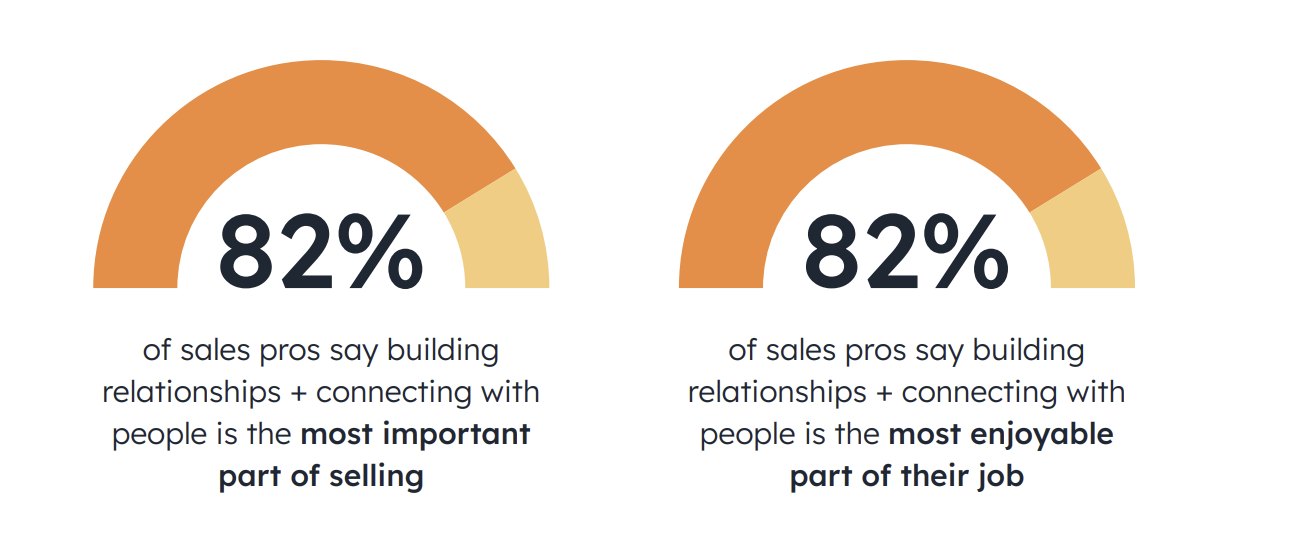 The importance of building relationships according to sales reps | HubSpot
The importance of building relationships according to sales reps | HubSpot69% of sales professionals feel their job is tougher due to economic challenges (Salesforce).
Sales and marketing team's statistics
When sales and marketing work together, lead quality and conversion rates improve.
Aligning both teams creates a smoother path to closing deals.
Companies that align their sales and marketing teams see major benefits: a 38% higher win rate and 208% more marketing revenue (WinSavvy)
24% of high-performing sales teams emphasize a culture of trust among representatives, compared to only 13% of underperforming teams (HubSpot).
Only 30% of sales professionals believe their sales and marketing teams are closely aligned within their company (HubSpot).
40% of sales teams struggle with lengthy onboarding processes, which impacts productivity (Prezentor).
Only 19% of companies have fully aligned their departments, which shows a lot of room for improvement (Strava Tech Group).
For smaller companies (less than 50 employees), the average ratio is 0.8 marketing professionals per 1 salesperson (Banzai).
Nearly two-thirds of companies report that their marketing and sales teams report to the same leaders (Banzai).
91% of marketing content goes unused by sales teams because of misalignment (WinSavvy).
Companies with aligned sales and marketing efforts also see profit growth 27% faster over three years (WinSavvy).
Conclusion
Sales representatives who stay updated on the state of sales have a clear advantage. Use PhantomBuster along with these key sales statistics to sharpen your sales strategies, refine your approach, and hit your targets.
Try it free today and see the difference it makes in your sales success!

